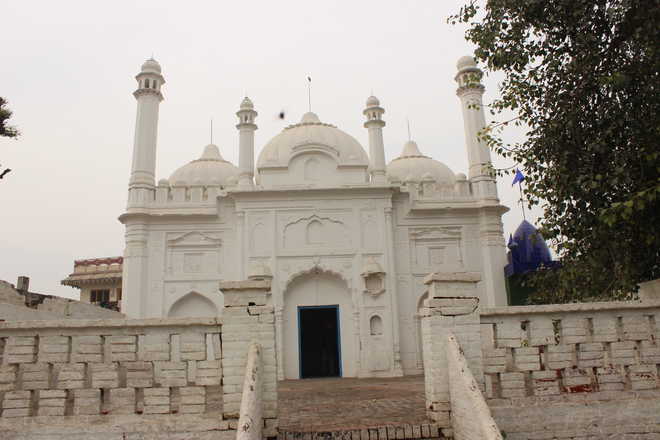
Preserving the legacy: One is struck by the recently redone white domes and minarets of the mosque, besides the cleanliness of the sanctum sanctorum; and (top left) the inner dome, which is inlaid with ornate meenakari and Islamic calligraphy Photos by the writer
Prabhjot Sohal
Partition and the subsequent migration of population on either side of the India-Pakistan border have had such effects that even after 70 years, these remain indelible. Among tales of human loss and abandonment, fading memories and the elusive weight of historical baggage felt by generations, are also the silent relics and remains of the pre-Partition settlements.
After Partition, as the deserted settlements on either side of the Radcliffe Line were being repopulated with the incoming migrants, structures built for domestic comfort were being readily occupied or rebuilt. However, it was the abandoned places of worship — the temples, gurdwaras, churches and mosques — that posed several awkward questions to the migrants. In the aftermath, the politically spewed hatred for the other clashed with the generations-old tacit rules of respect and reverence. This saw some religious places destroyed to rubbles, while some were carefully avoided and forgotten.
The 70th year since Partition, being an unusual landmark, has witnessed an inexplicable agency — an existential cry, almost verging on the spiritual — in the civil society to unbury the past and preserve experiences of the unfathomable event. Feeling a similar tug at his heart, Sandeep Singh Virk, 42, decided to renovate a historical mosque in his village Rashidan in Jind district, Haryana, on his own last year.
In a state that has recently bred incidents of religious polarisation — Ballabhgarh, Faridabad riots over mosque renovation in 2015, the stabbing of a 17-year-old Muslim boy over a minor dispute and the violence against an imaam in Hisar by activists of the Bajrang Dal in July last — restoring a mosque can be a risky endeavour. But, for Sandeep, who returned to his village a few years ago to take up farming, the pros of connecting with the past outweighed the cons. “I spent my childhood playing inside the mosque premises. It was also used as a school once. A couple of years ago, I realised that it was a valuable piece of heritage and should be restored,” says Sandeep.
Before Partition, Rashidan was pre-dominantly a Muslim village, with a few Hindus who worked in the farms of the Muslim landowners. Today, it is the Sikhs from the other side of the border who have replaced the landowning class of the village. Situated on Punjab-Haryana border, the peaceful village is bestowed with beauty and prosperity by the Bhakra canal. The villagers retell the secular beginning of the village. “This area was a part of the Patiala state. In the mid-19th century, the Maharaja of Patiala gave about 2,400 acres to the maulvi who taught children. The village is named after the maulvi’s daughter Rashidan. The nearby mazaar is that of the maulvi and his daughter. The mosque was built in the 1860s,” informs Amir Singh, 75, a member of the Shiromani Gurdwara Parbandhak Committee (SGPC), who migrated from Pakistan after Partition.
“When we migrated to this village, Sikhs had no place of worship. We placed Guru Granth Sahib in the mosque and started praying here till we had the resources to build our own gurdwara. The mosque is also a guru ka ghar for us, the villagers have always revered it,” adds Amir. The mosque yard was briefly used for the panchayat meetings and it was also an anganwadi centre for some time. Unlike other villages, where abandoned mosques were encroached upon or turned into livestock sheds, the sanctity of the mosque has been maintained.
The village panchayat has appointed Sukhchain Singh as the caretaker of the mosque. As Sukhchain gives a tour of the mosque, one is struck by the recently redone pristine white domes and minarets of the mosque. Cleanliness of the sanctum sanctorum, beauty of the inner dome inlaid with ornate meenakari and Islamic calligraphy are a treat to eyes. “We did not have the craftsmen or the resources to restore the art work inside, so we decided to just keep it clean and not mess with it. A lot can be done. I have been trying to get an electricity connection for the mosque as well,” adds Sandeep.
In 2012, Sandeep visited his ancestral village in Sheikhupura and Nankana Sahib — the birth of the first Sikh guru, Guru Nanak — in Pakistan. He was moved when he saw how well the locals had taken care of the historic gurdwaras. Among others, he befriended in Pakistan was Bilal Ahmed Virk, a member of the National Assembly of Pakistan from Nankana Sahib. Virk, informs Sandeep, has lobbied for the the upkeep of Gurdwara Janam Asathan — one of Sikhism’s holiest sites. “When Bilal came to India two years ago, he also visited the village. He saw that the mosque was in a ruined state and asked if we needed help with the restoration process. It was embarrassing to realise that he was doing so much for religious places in Pakistan, while we haven’t done much. I told him we would rebuild it on our own because the mosque was our heritage too,” says Sandeep, who has also been trying to locate the original inhabitants of the village.
“When I shared the pictures of the renovated mosque with my friends in Pakistan, they were overwhelmed. I have been searching for them, but have not been able to find anyone,” he adds. On a WhatsApp message from Pakistan, Bilal says, “People on both sides of the border should respect and take care of the mosques, gurdwaras, temples and churches or any monument that is part of the heritage; it is an act in good faith. With such actions, communities across the border come closer to each other. It is very important for humanity and human development, to have love and respect for all communities.”



























